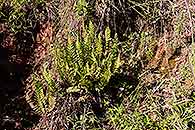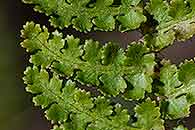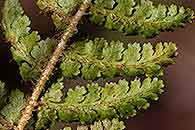Synonyms |
Mohria caffrorum auct. non (L.) Desv.
Mohria caffrorum (L.) Desv. var. ferruginea J.E.Burrows & S.M.Burrows
Anemia nudiuscula (J.P.Roux) Christenh.
|
Common name |
|
Description |
Rhizome shortly creeping, short, up to 10 mm in diameter; rhizome scales chestnut to rust-coloured, 5-7 mm long, narrowly lanceolate in outline, margin entire. Fronds closely spaced, tufted, few, spreading or erect, up to 90 cm long, slightly dimorphic with fertile fronds slightly longer than sterile fronds. Stipe 2-22 cm long, sparsely to densely set with mixture of hairs and scales, becoming glabrous at maturity. Lamina coriaceous, 5.3-63.5 cm long, narrowly elliptic in outline, pinnate to 2-pinnatifid, with 7-34 pairs of pinnae. Pinnae ovate to narrowly ovate in outline, hairless or nearly so on upper surface, undersurface with hairs and scales along the rhachis and veins; pinnule margins shallowly crenulate to obtusely toothed. Rachis densely set with hairs and scales. Sori marginal at lobe apices, exindusiate.
|
Notes | Difficult to distinguish from M. vestita. M. nudiuscula has a thickly coriaceous and often a less dissected lamina with hairless or nearly hairless upper surface; the margins are notched with shallowly rounded teeth.
|
|---|
Derivation | nudiuscula: somewhat bare or naked, the upper surface of the lamina is almost hairless. |
|---|
Habitat | Seasonally moist montane grassland and forest margin, rocky places by waterfalls, exposed or shaded.
|
|---|
Distribution worldwide | Africa, Madagascar.
|
|---|
Distribution in Africa |
Dem. Republic of Congo, Lesotho, Malawi, Mozambique, South Africa, Tanzania , Zambia, Zimbabwe. |
Growth form |
Terrestrial. |
Literature |
Burrows, J.E. (1990) Southern African Ferns and Fern Allies. Frandsen, Sandton. Pages 63 - 64. Description of M. caffrorum! Revision by J.P. Roux: M. caffrorum now restricted to S.A., M. vestita and M. nudiuscula new species for Zimbabwe. (Includes a picture).
Crouch, N.R., Klopper, R.R., Burrows, J.E. & Burrows, S.M. (2011) Ferns of Southern Africa, A comprehensive guide. Struik Nature. Pages 208 - 209. (Includes a picture).
Jacobsen, W.B.G. (1983) The Ferns and Fern Allies of Southern Africa. Butterworths, Durban and Pretoria. Pages 177 - 178. Description of M. caffrorum! Revision by J.P. Roux: M. caffrorum now restricted to S.A., M. vestita and M. nudiuscula new species for Zimbabwe. (Includes a picture).
Kornas, J. (1979) Distribution and ecology of the Pteridophytes in Zambia. Polska Akademia Nauk Wydzial II Nauk Biologicznych. Page 43. As Mohria caffrorum
Roux, J.P. (2001) Conspectus of Southern African Pteridophyta.Southern African Botanical Diversity Network Report, 13 Page 54.
Roux, J.P. (2009) Synopsis of the Lycopodiophyta and Pteridophyta of Africa, Madagascar and neighbouring islands. Strelitzia 23, South African National Biodiversity Institute, Pretoria. Pages 52 - 53.
Roux, J.P. (1995) Systematic studies in the genus Mohria (Pteridophyta: Anemiaceae). VI. Taxonomic review.Bothalia, 25(1) Pages 9 - 11. (Includes a picture).
Schelpe, E.A.C.L.E. (1970) Pteridophyta.Flora Zambesiaca, 0 Page 56. Description of M. caffrorum! Revision by J.P. Roux: M. caffrorum now restricted to S.A., M. vestita and M. nudiuscula new species for Zimbabwe.
Verdcourt, B. (2000) Schizaeaceae.Flora of Tropical East Africa, Page 8. (Includes a picture).
|





